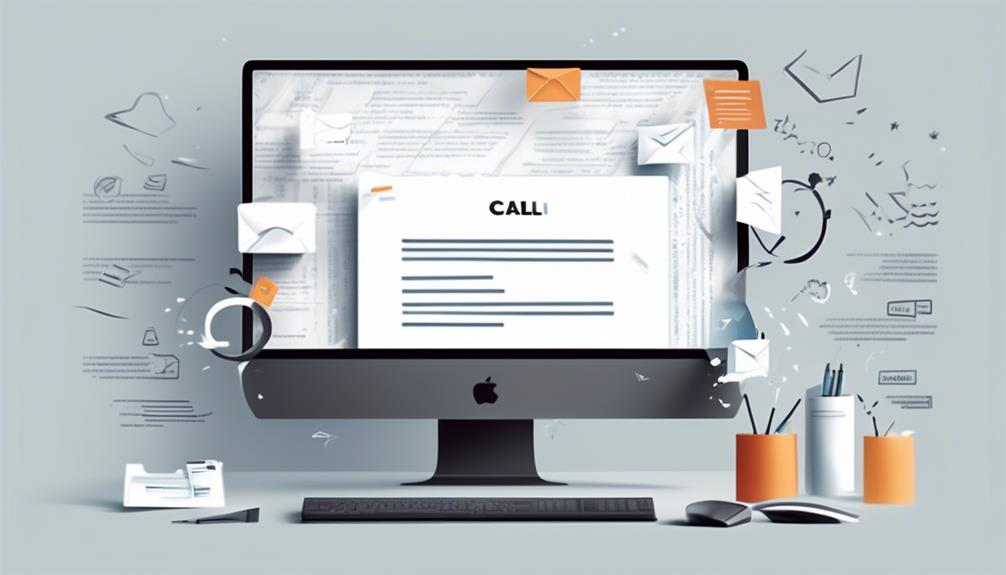Most of us have likely faced the perplexity of trying to set up a meeting or a deadline over email with someone in a distinct time zone. However, were you aware that there are particular rules for indicating time zones in emails to guarantee clear communication?
Getting time zones right can make a significant difference in ensuring that everyone is on the same page when it comes to timing. Understanding the proper way to write time zones can help avoid misunderstandings and ensure that your emails are professional and clear.
So, let's explore the best practices for including time zones in emails to make sure our communication is precise and effective.
Key Takeaways
- Including time zones in emails is important for clear communication and avoiding misunderstandings, especially when dealing with colleagues or clients in different time zones.
- Guidelines for using time zone abbreviations include using three-letter abbreviations, determining your own time zone first, and expressing the time in the recipient's time zone.
- Consistency in using time zone abbreviations is crucial, including using appropriate abbreviations for specific time zones and being familiar with GMT and UTC for international correspondence.
- Capitalization rules for time zones should be followed, including capitalizing the full name of the time zone for consistency and professionalism, using lowercase for subsequent references, and lowercase for shortened forms within the body of a sentence.
Showing Time Zones in Emails
When sending emails with time-sensitive information, it's crucial to include the time zone to ensure clear communication across different locations. This is particularly important when dealing with colleagues or clients in different time zones such as Eastern, Central, or those observing Daylight Saving Time.
The AP Style guidelines recommend specifying the time zone using three-letter abbreviations, such as EST for Eastern Standard Time or CDT for Central Daylight Time. The first step is to determine your own time zone and then express the time in the recipient's time zone.
For example, if I'm in the Eastern Standard Time (EST) zone and scheduling a meeting for 10:00 AM, I'd express it as 10:00 AM EST/9:00 AM CST to provide clarity. This method ensures that recipients in different time zones can quickly and accurately interpret the scheduled time.
Using Time Zone Abbreviations

To ensure clarity and precision in email communication, we consistently use the appropriate time zone abbreviations when referencing specific times. When mentioning Central Time, for example, we should use 'CT' in a clear and consistent manner.
Similarly, for Pacific Standard Time, the appropriate abbreviation is 'PST,' and for Eastern Standard Time, it's 'EST.' It's important to note that Eastern Time, or ET, may refer to either Eastern Standard Time or Eastern Daylight Time, depending on the time of year.
When dealing with international correspondence, it's crucial to be familiar with Greenwich Mean Time (GMT) and Coordinated Universal Time (UTC). These serve as standard points of reference and can avoid confusion when scheduling meetings across different time zones.
Additionally, when planning calls or events, it's essential to be mindful of daylight saving time changes and adjust the time zone abbreviation accordingly.
Capitalizing Time Zones

Capitalizing the full name of the time zone, such as Eastern Standard Time or Pacific Standard Time, is essential for maintaining consistency and professional communication. When writing about time zones, it is important to use the full name of the zone, especially in the first reference. However, when used within the body of a sentence or in subsequent references, lowercase is appropriate for shortened forms like 'the Eastern time zone' or 'Mountain time.' Additionally, when linking time zone abbreviations with a clock reading, such as 'noon EST' or '9 a.m. PST,' it is acceptable to use the abbreviated form in lowercase. It's crucial to follow a specific style guide, such as Chicago or AP, and maintain consistency in capitalization throughout the document. To help illustrate this, here is a table showcasing some common time zones, their abbreviations, and the hours behind Coordinated Universal Time (UTC).
| Time Zone | Abbreviation | Hours Behind UTC |
|---|---|---|
| Eastern Standard Time | EST | 5 |
| Pacific Standard Time | PST | 8 |
| Central Standard Time | CST | 6 |
| Mountain Standard Time | MST | 7 |
| Greenwich Mean Time | GMT | 0 |
Incorporating Daylight Saving Time

Incorporating Daylight Saving Time into our schedules requires careful planning and consideration of the shift in time. Daylight Saving Time is indicated by the abbreviation EDT, which stands for Eastern Daylight Time. During Daylight Saving Time, Eastern Time is four hours behind Coordinated Universal Time (UTC).
When writing about Daylight Saving Time, use the full name Eastern Daylight Time in accordance with AP Style guidelines. When scheduling events during Daylight Saving Time, use Time and Date's time zone converter for accurate time representation.
It's crucial to ensure the correct abbreviation EDT is used on first reference when mentioning Daylight Saving Time. This is especially important when considering zones used within the continental United States, as well as when linked with a clock.
Understanding the intricacies of Daylight Saving Time is vital for effectively communicating global time differences and ensuring the accuracy of time-sensitive communications. Therefore, incorporating Daylight Saving Time into our time zone management is essential for maintaining precision and consistency in our email communications.
Understanding GMT and UTC
In our effort to ensure precision and consistency in our email communications, understanding GMT and UTC as reference points for international time zones is crucial for effectively scheduling meetings and calls across different regions.
When writing time zones in emails, it's essential to make sure that the reference to a specific time zone is accompanied by a clock reading in GMT or UTC. This practice helps in avoiding confusion and ensures that all parties are aligned on the correct time for the meeting or call.
Additionally, using time zone converters can aid in accurately determining the corresponding time in different regions.
Consistently adhering to a standardized use policy for mentioning time zones in emails is vital. This includes the consideration of daylight saving time and its impact on time differences, especially when scheduling meetings across regions that observe this practice.
Understanding the relationship between GMT, UTC, and specific time zones, such as Central Standard Time (CST), is fundamental in effectively coordinating global schedules.
Frequently Asked Questions
How Do You Mention Time Zones in Email Signature?
We always include time zones in our email signatures to ensure clarity and avoid confusion.
It's important to accurately represent the time zone we're in, especially when corresponding with individuals in different locations.
This simple addition helps to streamline communication and prevents any misunderstandings regarding meeting times or deadlines.
It's a small but essential detail that demonstrates our professionalism and consideration for the recipient's convenience.
How Do You Write Time Zones in a Sentence?
We write time zones in a sentence by using the appropriate abbreviation, such as EST for Eastern Standard Time or PDT for Pacific Daylight Time, and placing it after the time. This helps to clearly communicate the specific time zone to the recipient.
It's essential to include this information to avoid any confusion or misunderstandings when scheduling meetings or coordinating activities across different time zones.
How Do I Clarify Time Zone in Email?
We clarify the time zone in email by including the abbreviation for the time zone, such as EST or PST, after the specific time. This helps the recipient understand the time reference and prevents confusion.
It's important to be clear and consistent when communicating time zones in emails to ensure that all parties involved are on the same page regarding the timing of events or meetings.
How Do You Type Time Zones?
We type time zones by using their full names in AP Style, capitalizing the first letter of each word.
When using abbreviations, we ensure clarity and consistency. It's important to specify time zones when communicating with individuals in different time zones to avoid confusion.
Always include UTC in conference call invitations for international communication. We avoid inserting periods after the letters of a time zone abbreviation and don't enclose time zone abbreviations in commas.
Conclusion
In conclusion, when writing time zones in emails, it's crucial to be clear and consistent to avoid any confusion. Remember the adage, 'Time is of the essence,' and always include the full name or abbreviation of the time zone to ensure accurate communication.
By following these guidelines and considering daylight saving time, you can effectively convey the timing of your message to recipients in different regions.










